Libya Tourist Information and Tourism
(Libya, LY, North Africa)
Libya is currently considered to be a war zone and therefore you should note that travelling in this country is extremely dangerous at present, due to aerial bombing, armed forces and military attacks. Most governments throughout the world have issued travel warnings. For further information, contact your local embassy.
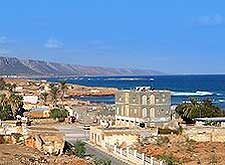
The North African country of Libya is about as far removed as possible from being a traditional holiday destination, and yet the more intrepid of tourists and travellers do choose to come here, looking for a vacation with a difference. Libya contains a surprising quantity of ancient history, boasting historic cities with Roman and Greek pasts, World Heritage Sites and pockets of remaining Byzantine architecture.
The beautiful Mediterranean coastline of Libya contrasts heavily with the Sahara Desert, which dominates so much of this country. Destinations such as Ghat and Ghadames serve as oasis towns, while
Tripoli is the capital - this crowded seaport city resides on the north-western coastline. Tripoli is the main place to come for general Libya tourist information, with several tour operators and travel agencies situated here, offering tourism advice and guide-led expeditions.
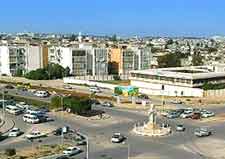
Libya Tourist Information and Tourism: Top Sights
It should certainly be noted that independent travellers are not currently permitted in Libya. Instead, tourists are only allowed to enter the country as part of an official organised tour, although much flexibility can be built into the planned route. Since Libya is such an enormous country, guided tours do have the distinct advantage that you will be able to see so much more than you would likely know existed, without extensive research.
Consider exploring the coastal attractions lying along the north-western shoreline, where some rather attractive palm-fringed sandy beaches await tourists. A number of the finest Libyan beaches are to be found around Zuwarah and Sabratha, such as the beaches of Tileel and Ras Alteen. On the north-eastern coast are a selection of additional beach towns and resorts, with Al-Nakheel Beach at Benghazi standing out as being a good place to try your hand at windsurfing. More information about
Libya Beaches.
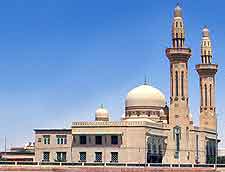
Libya has made a concerted effort to look after its oldest and most important buildings, preserving its heritage for future generations to enjoy. Many of the most remarkable and historic attractions stand in Tripoli, spread around the city centre and the atmospheric and characterful Medina Quarter. Al-Saraya Al-Hamra Castle, a palace complex also named the Red Castle, is one of Tripoli's most distinctive sights and is clearly visible from much of the city. The life of the Red Castle began in the 7th century, although it was greatly rebuilt and restructured during the 18th and 19th centuries. Also in Tripoli is the famous Arch of Marcus Aurelius, the Gurgi Mosque and Karamanli House, as well as the Green Square (Martyrs Square), the heart of the city and the site of many recent public demonstrations. More information about
Libya Tourist Attractions.
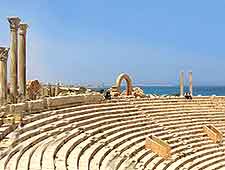
The most striking landmarks of Libya are often those of a natural kind and these include extinct volcanoes, mountains, lakes and giant dunes, such as the much-photographed Zallaf Sand Dunes. The Green Mountains warrant a look, with cascading waterfalls and pretty gorges awaiting visitors here, as well as the numerous Ubari Lakes, where swimming is possible. Not to be missed are the Jebel Acacus Mountains - home of some outstanding prehistoric rock art and scenic dry channels, which can be hiked along if you have the time.
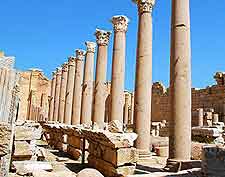
Sited on the eastern side of Tripoli and featuring Mediterranean vistas is the Leptis Magna Historic Site, a Roman city with many well-preserved remains, including temples, marketplaces, bathhouses, a basilica and an amphitheatre. Also enjoying a setting along coastal Libya is the archaeological site of Sabratha, an ancient Phoenician trading post which was at the height of its Roman prosperity between the 2nd century and the 3rd century. Cyrene is a further ancient city, packed with spectacular Greek temples and regularly visited by tour groups. More information about
Libya Landmarks and Monuments.
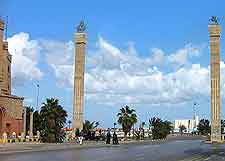
As you would expect, Tripoli is where some of Libya's most noteworthy museums and similar attractions are located, with information relating to major events, past battles and old civilisations. Part of the Al-Saraya Al-Hamra Castle is the Jamahiriya Museum, which now ranks amongst the country's leading attractions and features endless galleries, archeological goodies and Libyan artefacts, as well as Greek exhibits and Gaddafi paraphernalia. Also to be found within the city is the recently upgraded Islamic Museum of Tripoli, where an Ottomon-Turk courtyard adds an undeniable Mediterranean flavour. Further quality museums await visitors at Ghadames, Leptis Magna, Qasr and Sabratha, with regional history on display within organised gallery spaces. More information about
Libya Museums.
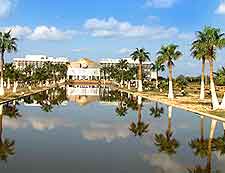
Although Libya is bordered by some very appealing African countries, crossing the borders can often be problematic and may need much advance organisation. The simplest way to explore neighbouring countries is to fly from Tripoli International Airport, where short flights to
Cairo International Airport (
Egypt) are extremely popular. Tourists on holiday in Libya may also like to consider flights to neighbouring
Algeria (
Algiers), Chad (N'Djamena), Niger (Niamey), Sudan (Khartoum) and Tunisia (Tunis), the latter of which lies on the country's far north-western corner and has glorious sandy beaches. Notable Tunisian beach resorts include Hammamet, La Goulette, Monastir, Skanes and Sousse, together with the southerly island of Djerba, and to some extent, the capital of Tunis. More information about
Libya Attractions Nearby.
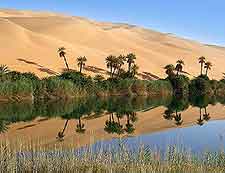
More Libya Information / Fast Facts and Orientation
- Country: Libya, North Africa
- Location: Maghreb region / next to the Mediterranean Sea
- Status: African Country
- Capital city: Tripoli
- Area: approximately 695,000 square miles / 1.8 million square kilometres
- Population: approximately 6.5 million
- Language: Arabic and Berber
- Currency: Dinar (LYD)
- Time zone: GMT / UTC +1
- Country dialling code: +218
- Religion: mainly Sunni Muslims, also some small Christian communities
- Average daily Libya January temperature: 19°C / 66°F
- Average daily Libya July temperature: 38°C / 100°F
 The North African country of Libya is about as far removed as possible from being a traditional holiday destination, and yet the more intrepid of tourists and travellers do choose to come here, looking for a vacation with a difference. Libya contains a surprising quantity of ancient history, boasting historic cities with Roman and Greek pasts, World Heritage Sites and pockets of remaining Byzantine architecture.
The North African country of Libya is about as far removed as possible from being a traditional holiday destination, and yet the more intrepid of tourists and travellers do choose to come here, looking for a vacation with a difference. Libya contains a surprising quantity of ancient history, boasting historic cities with Roman and Greek pasts, World Heritage Sites and pockets of remaining Byzantine architecture.
 Libya has made a concerted effort to look after its oldest and most important buildings, preserving its heritage for future generations to enjoy. Many of the most remarkable and historic attractions stand in Tripoli, spread around the city centre and the atmospheric and characterful Medina Quarter. Al-Saraya Al-Hamra Castle, a palace complex also named the Red Castle, is one of Tripoli's most distinctive sights and is clearly visible from much of the city. The life of the Red Castle began in the 7th century, although it was greatly rebuilt and restructured during the 18th and 19th centuries. Also in Tripoli is the famous Arch of Marcus Aurelius, the Gurgi Mosque and Karamanli House, as well as the Green Square (Martyrs Square), the heart of the city and the site of many recent public demonstrations. More information about Libya Tourist Attractions.
Libya has made a concerted effort to look after its oldest and most important buildings, preserving its heritage for future generations to enjoy. Many of the most remarkable and historic attractions stand in Tripoli, spread around the city centre and the atmospheric and characterful Medina Quarter. Al-Saraya Al-Hamra Castle, a palace complex also named the Red Castle, is one of Tripoli's most distinctive sights and is clearly visible from much of the city. The life of the Red Castle began in the 7th century, although it was greatly rebuilt and restructured during the 18th and 19th centuries. Also in Tripoli is the famous Arch of Marcus Aurelius, the Gurgi Mosque and Karamanli House, as well as the Green Square (Martyrs Square), the heart of the city and the site of many recent public demonstrations. More information about Libya Tourist Attractions. The most striking landmarks of Libya are often those of a natural kind and these include extinct volcanoes, mountains, lakes and giant dunes, such as the much-photographed Zallaf Sand Dunes. The Green Mountains warrant a look, with cascading waterfalls and pretty gorges awaiting visitors here, as well as the numerous Ubari Lakes, where swimming is possible. Not to be missed are the Jebel Acacus Mountains - home of some outstanding prehistoric rock art and scenic dry channels, which can be hiked along if you have the time.
The most striking landmarks of Libya are often those of a natural kind and these include extinct volcanoes, mountains, lakes and giant dunes, such as the much-photographed Zallaf Sand Dunes. The Green Mountains warrant a look, with cascading waterfalls and pretty gorges awaiting visitors here, as well as the numerous Ubari Lakes, where swimming is possible. Not to be missed are the Jebel Acacus Mountains - home of some outstanding prehistoric rock art and scenic dry channels, which can be hiked along if you have the time. Sited on the eastern side of Tripoli and featuring Mediterranean vistas is the Leptis Magna Historic Site, a Roman city with many well-preserved remains, including temples, marketplaces, bathhouses, a basilica and an amphitheatre. Also enjoying a setting along coastal Libya is the archaeological site of Sabratha, an ancient Phoenician trading post which was at the height of its Roman prosperity between the 2nd century and the 3rd century. Cyrene is a further ancient city, packed with spectacular Greek temples and regularly visited by tour groups. More information about Libya Landmarks and Monuments.
Sited on the eastern side of Tripoli and featuring Mediterranean vistas is the Leptis Magna Historic Site, a Roman city with many well-preserved remains, including temples, marketplaces, bathhouses, a basilica and an amphitheatre. Also enjoying a setting along coastal Libya is the archaeological site of Sabratha, an ancient Phoenician trading post which was at the height of its Roman prosperity between the 2nd century and the 3rd century. Cyrene is a further ancient city, packed with spectacular Greek temples and regularly visited by tour groups. More information about Libya Landmarks and Monuments. As you would expect, Tripoli is where some of Libya's most noteworthy museums and similar attractions are located, with information relating to major events, past battles and old civilisations. Part of the Al-Saraya Al-Hamra Castle is the Jamahiriya Museum, which now ranks amongst the country's leading attractions and features endless galleries, archeological goodies and Libyan artefacts, as well as Greek exhibits and Gaddafi paraphernalia. Also to be found within the city is the recently upgraded Islamic Museum of Tripoli, where an Ottomon-Turk courtyard adds an undeniable Mediterranean flavour. Further quality museums await visitors at Ghadames, Leptis Magna, Qasr and Sabratha, with regional history on display within organised gallery spaces. More information about Libya Museums.
As you would expect, Tripoli is where some of Libya's most noteworthy museums and similar attractions are located, with information relating to major events, past battles and old civilisations. Part of the Al-Saraya Al-Hamra Castle is the Jamahiriya Museum, which now ranks amongst the country's leading attractions and features endless galleries, archeological goodies and Libyan artefacts, as well as Greek exhibits and Gaddafi paraphernalia. Also to be found within the city is the recently upgraded Islamic Museum of Tripoli, where an Ottomon-Turk courtyard adds an undeniable Mediterranean flavour. Further quality museums await visitors at Ghadames, Leptis Magna, Qasr and Sabratha, with regional history on display within organised gallery spaces. More information about Libya Museums. Although Libya is bordered by some very appealing African countries, crossing the borders can often be problematic and may need much advance organisation. The simplest way to explore neighbouring countries is to fly from Tripoli International Airport, where short flights to Cairo International Airport (Egypt) are extremely popular. Tourists on holiday in Libya may also like to consider flights to neighbouring Algeria (Algiers), Chad (N'Djamena), Niger (Niamey), Sudan (Khartoum) and Tunisia (Tunis), the latter of which lies on the country's far north-western corner and has glorious sandy beaches. Notable Tunisian beach resorts include Hammamet, La Goulette, Monastir, Skanes and Sousse, together with the southerly island of Djerba, and to some extent, the capital of Tunis. More information about Libya Attractions Nearby.
Although Libya is bordered by some very appealing African countries, crossing the borders can often be problematic and may need much advance organisation. The simplest way to explore neighbouring countries is to fly from Tripoli International Airport, where short flights to Cairo International Airport (Egypt) are extremely popular. Tourists on holiday in Libya may also like to consider flights to neighbouring Algeria (Algiers), Chad (N'Djamena), Niger (Niamey), Sudan (Khartoum) and Tunisia (Tunis), the latter of which lies on the country's far north-western corner and has glorious sandy beaches. Notable Tunisian beach resorts include Hammamet, La Goulette, Monastir, Skanes and Sousse, together with the southerly island of Djerba, and to some extent, the capital of Tunis. More information about Libya Attractions Nearby.